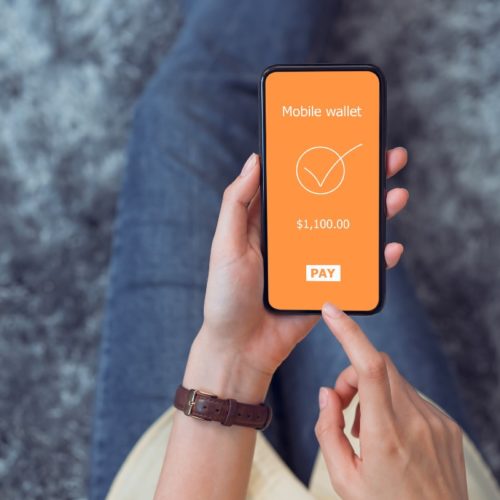A long time ago people used paper currency called “checks” to pay their bills. You might remember checks. They are rectangular pieces of paper with your bank account number and routing number written on the bottom.
Now, in the era of Venmo, PayPal, Apple Wallet, etc. – there are so many faster ways to pay bills without using paper checks.
But one thing has remained true. No matter how many technological advances we’ve made as a society – the checking account is still as relevant as ever.
What Is a Checking Account and How Does It Work?
A checking account is a type of bank account that allows you to make regular deposits, withdrawals, and payments.
Every checking account has a unique account number, plus something called a “routing number,” which gives electronic instructions that tell the computers where to direct the transaction.
Unlike savings accounts, there are few federal regulations that prohibit regular spending in a checking account. Some checking accounts require a minimum balance, and some have monthly fees.
But checking accounts were designed to be a payment account – this means consumers can deposit as much money as they’d like and also take out as much as they like for payments.
With the dawn of new technology, few people use checks for the majority of their payments. But digital transactions work surprisingly similar.
You can link platforms like Venmo and PayPal directly to your checking account so that, when you send money, the banks communicate electronically and transmit the appropriate funds.
Types of Checking Accounts
Most checking accounts function similarly, but there are different kinds of checking accounts depending on your needs.
The most common types of checking accounts are standard checking accounts and online checking accounts, but here is a breakdown of most types of checking accounts out there:
Standard Checking Accounts
- Good For: People who prefer a physical bank.
- Pros: East access to ATMs at physical branches nationwide. Often include online banking and other services like budgeting tools.
- Cons: Usually require a minimum balance or monthly service fee. It also comes with overdraft charges and fees for out-of-network ATMs.
Learn More: Best FREE Checking Accounts and our take on the Best Checking Accounts
Online Checking Accounts
- Good For: People who want virtual access to their checking account anywhere they go and don’t care about a brick-and-mortar location.
- Pros: Lower fees (due to lower overhead), plus higher interest rates to combat inflation.
- Cons: No physical location, international customer service, limited ATM access (sometimes).
Learn More: Best Online Checking Accounts
Premium Checking Accounts:
- Good For: Customers making regular large deposits, and individuals with high net worth.
- Pros: Complimentary services and financial planning resources, higher-yield interest.
- Cons: Higher minimum balances and fees.
Business Checking Accounts:
- Good For: LLCs and Sole Proprietors with a unique tax ID number who want to separate personal finances from business finances,
- Pros: Higher spending and withdrawal limits, plus tools for business finance and accounting.
- Cons: Higher balance requirements, higher fees, stricter fees on excess transactions and cash deposits
Learn More: Best Business Checking Accounts
Student Checking Accounts
- Good For: Students, because they have lower fees and minimum balance requirements.
- Pros: Often include personal finance tools and lessons.
- Cons: Age limits (cut off at about 26 years old), low spending and/or withdrawal limits (usually under $2500 one-time)
Senior Checking Accounts:
- Good For: Seniors, people in retirement
- Pros: Low or waived monthly fees, free checks, and money orders.
- Cons: Age restrictions, plus they are becoming increasingly uncommon.
Second Chance Checking Accounts:
- Good For: Individuals with poor banking histories who don’t qualify for other accounts. People who want to rebuild their credit history.
- Pros: Low opening deposits.
- Cons: Monthly fees, and they are also uncommon.
Learn More: Best Checking Account Signup Bonuses
Checking Account Fees
As you can see, there are many kinds of checking accounts. Depending on your needs, you can find one that’s right for you.
That said – no matter what kind you choose, you are bound to run into some fees. Some fees are avoidable, but only if you know what to look for.
How To Avoid a Monthly Service Fee
Many checking accounts charge a monthly service fee. These are often avoidable, as long as you maintain a monthly minimum balance.
Typically, the minimum balance requirements range from $200-500. This will be calculated one of a few different ways.
One way is a monthly minimum balance, where your account is only charged if the average daily balance is lower than a certain amount. Monthly minimum balance fees are charged at the end of every statement, or once a month.
There is also such a thing as a daily minimum balance, and these fees can hit you hard if you aren’t prepared. Daily minimum balance fees can be applied on any day that your account drops below the minimum balance.
That’s why it’s important to ask what kind of checking account fees apply to your account before you open it.
What Is An Overdraft Fee?
Overdraft fees are another common checking account fee. This is a one-time fee that you will be charged if you ever spend more than your checking account balance.
For example, if you have $250 left in your checking account, and accidentally authorize a transaction for $300, you will be hit with an overdraft fee.
Overdraft fees are sometimes waived if you call and ask your bank for forgiveness. Sometimes you can avoid overdraft fees altogether if you link your checking account with your savings or a personal line of credit as a backup account.
When this happens, if you spend more than your balance, your bank automatically transfers the amount you need from your backup account to cover the bill.
This strategy can be helpful, but you must remember that most savings accounts have a maximum number of withdrawals you can make every month. If you’re using your savings account as a backup, it should be just that – used sparingly.
It’s always a good idea to have a checking account buffer in case of any unexpected fees.
How To Choose The Right Checking Account
Choosing the right checking account comes down to knowing your financial habits well.
What Are Your Checking Needs?
Before you open a checking account, you first will want to have a strong understanding of your behaviors, habits, and needs.
For example, Do you know how much you spend every week? Every month? Do you plan on swiping your debit card, using Venmo, or writing checks (yes, people still write checks, though it is not as common)?
Do You Have a Direct Deposit?
Another question to ask yourself is whether your employer will be paying you via direct deposit.
Sometimes, using direct deposit can also help you waive your monthly fees, and it also prevents you from needing to run to the bank every time you get paid. If you get paid via direct deposit, then an online checking account would likely work for you.
Do You Keep A Certain Balance of Money?
Finally, ask yourself how much you plan on keeping in your checking account. People who automate their finances typically keep a cushion of 1-3 months of expenses in their checking account at all times. This way, they never overdraft and never dip below the minimum balance.
As you can see, there are many factors to consider when choosing a checking account. I recommend observing and tracking your spending habits for a week or so before making your final choice.
How To Open A Checking Account
Once you are ready to open a checking account, you can do it either in person or online. You will need a government ID, such as a passport or driver’s license. You will also need proof of residency, like a phone or utility bill.
You’ll also need to ask your bank what the minimum opening deposit is, and how you are going to make it. You can take cash, or a check from another account, such as your first paycheck.
What Is The Difference Between a Checking and a Savings Account?
Checking accounts and savings accounts are very similar, but they are designed for two different purposes.
They both have a routing number and account number, but because savings accounts are meant for long-term saving, the government has stricter regulations on how often you can withdraw from a savings account.
Checking accounts, on the other hand, are designed to store your liquid assets – meaning your spending money. Checking accounts are linked to your debit card which allows you to swipe and spend directly from your account.
There are also no limits as to how many accounts you can pay with your checking account. You can pay for subscriptions, credit card bills, utility bills, and more with a checking account using either your routing and account number or by simply entering your debit card information.
Because checking accounts are meant to be easily accessible and liquid, they are not the best for earning interest.
Savings accounts typically have a higher interest rate so that you can earn money on the money you’ve placed in the hands of your bank. The highest interest rates are typically through online savings accounts like Wealthfront or Betterment.
If you are in a financial situation that allows you to do so, you might want to consider a high-yield savings account that would earn you 2-3% interest on your balance.
Please note that you do have to pay taxes on interest earned in a checking account.
How To Protect Your Checking Account
After learning about checking accounts, you might be wondering what makes them any different than storing money under your mattress. If checking accounts cost fees and all they do is make your money easily accessible, then why are they even worth it?
Beyond giving you the ability to link your money to other goods and services through the internet faster than cash or checks ever will, putting your money in a checking account is also a means of insuring your cash.
That’s right –the vast majority of all checking accounts in the U.S. are insured by the FDIC – the Federal Deposit Insurance Corporation – for up to $250,000.
So, if there is ever a bank failure, you can trust that by putting your money in an FDIC-insured checking account, you will get it back.
This beats the old under-the-mattress trick any day.






No comments yet. Add your own